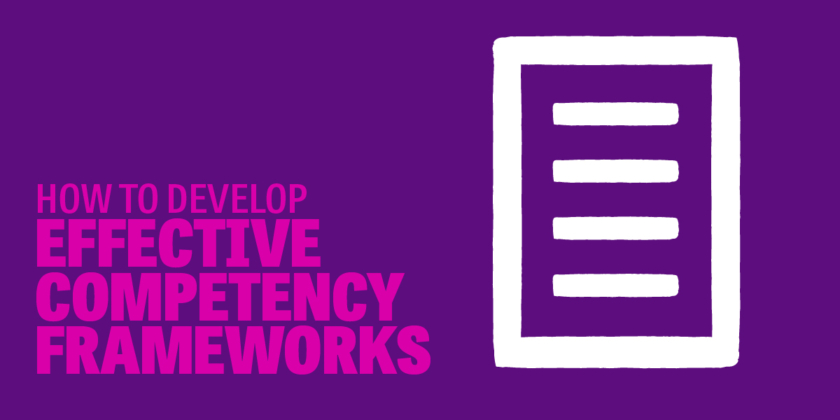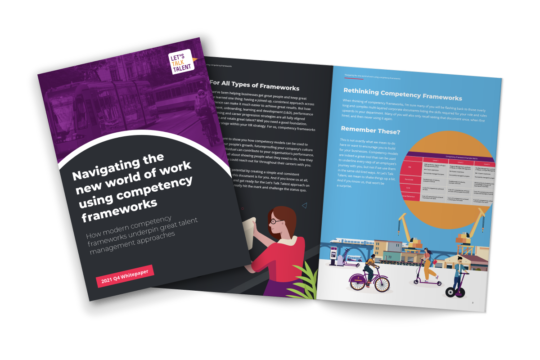Our approach to creating competency frameworks that lead to high performance
Most of us have experienced unclear expectations in the workplace. Whether this translated into not feeling appreciated whilst doing everything right, not understanding why certain people got ahead whilst others didn’t, or simply starting in a role that really wasn’t as advertised, we’ve all felt demotivated, unsure of what to do or how to get ahead. The great news is that most of these situations can probably be avoided. All that’s needed is a set of transparent, aspirational guide rails giving your people clarity on what is expected of them, what they need to do and how they need to do it to perform well and be successful within the business. Easy right? Yes, and no. How can you determine exactly what is expected of an employee, when everyone’s expectations may vary? How can you create a work environment that is inclusive, encourages the right behaviours and attitudes, and allows you to recruit the right staff and keep the right staff? In short, how do you even get started with getting great people and keeping great people?
In this article, you will learn:
- Revamping our approach to competency frameworks
- What are competency frameworks?
- How to build effective competency frameworks
- What to avoid when designing competency frameworks
- Developing effective competency frameworks
Revamping our approach to competency frameworks
At Let’s Talk Talent, we believe competency frameworks are the lynchpin that should underline every single pillar of your employee lifecycle. They are the perfect tool to use in order to provide staff with absolute clarity on how to be successful with you, and create the kind of benchmark that will allow you to unlock your people’s full potential. Competency frameworks, we hear you say? Those tired, old, complex, multi-layered documents full of corporate generic language we all read on induction day and then never use again?
Well, not exactly. Over the years, we’ve had plenty of experience creating, revamping and refining competency frameworks for a large variety of clients. We’ve come to know what works well; that’s why we’ve developed our very own, and ever so different, approach to creating dynamic competency frameworks that generate great results, whatever the issue you’re trying to solve.
For a few examples of competency frameworks that work, read our blog article.
What are competency frameworks?
Competency frameworks are an essential tool to help managers articulate to their team members:
- What they need to do to be successful within the organisation;
- How they need to do it;
- How they can navigate their careers with you.
They are not a job description or a list of generic skills. Competency frameworks go much further than that. They encompass the skills, sure, but also the training, the behaviours and the relationships needed in order to succeed within the business.
But once you’ve established the skills and behaviours that will allow your people to perform well within their roles, you can’t exactly just leave them to get on with it. Competency frameworks, once developed and rolled out to your people, require some follow-through. That’s why organisations should use them as the very foundation upon which to build their employee experience. This can be done by devising job adverts and interview questions that fit key roles better or creating customised career pathways for staff. It could also mean setting up diversity and inclusion initiatives that will foster the kind of inclusive behaviour you are hoping to see within the company. Competency frameworks ensure everyone is aware of all the ways they can contribute to helping you reach your objectives.
For some inspiration on how to use competency frameworks to have better career conversations, have a read here
How to build effective competency frameworks
At Let’s Talk Talent, our philosophy is made up of a healthy mix of science, art and humanities. The way we tackle competency frameworks is no different. So below is our approach to creating models that will speak to people’s heads, hearts and hands all at the same time. After all, life is too short for long, beige, bulleted lists of corporate jargon (read our HR definitions).
Step 1: Define your purpose
Before you launch into the design process, ask yourself: what’s the big problem you’re trying to solve? Or as we like to say, what’s your big exam question? Are you experiencing a high turnover rate? Is your internal culture not as inclusive as you’d like it to be? Are you lacking certain skill sets and need to develop your managerial, leadership or technical expertise? Once you’ve got a clear view of the end result, mapping out the way there can become much easier.
Step 2: Set some guidelines
Once the end goal is in sight, we like to start with establishing a few basic guidelines in order to keep the design process within set parameters. For example, Do you have any data to back up your initial hypothesis? How will you measure success in the future? Will you design competency frameworks for all levels within the organisation or focus on a few groups, such as managers and leaders? Will frameworks be shared across the organisation or is this a departmental exercise?
Step 3: Gather and analyse data
A data-centric approach is key in order to create frameworks that will truly reflect your organisational context. Conduct various interviews with leaders and managers to understand their long-term vision, objectives and business challenges. Once you have a fair bit of data, group your findings into themes and start drafting hypotheses. Then, select a few representatives from various teams to stress test those and complete missing information. Interviews can be set up on a one-to-one basis or as focus groups, depending on what would work best with your particular audience.
Step 4: Build the frameworks
This is where our secret weapon comes in handy: the STAR model. People are more than just a bulleted list of skills and as such, mapping out competency frameworks requires a more holistic approach. We believe in giving everyone absolute clarity on what they need to do to be successful, including:
- Skills: the skills they will require to perform well within their roles.
- Training: the effort they may have to put in to develop the skills and knowledge needed.
- Attributes: the traits and behaviours they will have to display in order to truly represent the organisation.
- Relationships: the particular networks they should develop during their career with you.
Creating such a comprehensive map will allow your talent pool to understand how to navigate a successful career with you. Competency frameworks that clearly articulate, in your own language, how to contribute to organisational goals can only lead to more targeted recruitment, tailored training and development plans, better suited career pathways, a more inclusive internal culture and higher performance levels.
What to avoid when designing competency frameworks
Over the years, we’ve helped quite a few clients create dynamic, aspirational models, so here is a quick list of the common pitfalls to avoid during the creation process:
- Creating overly complex documents. Make sure you keep them simple.
- Including lots of generic corporate bullc*ap. If all your models state communication, teamwork or leadership as the main skills required, it’s time to dig a little deeper into what good looks like within your organisation.
- Generating reams of paper. Competency frameworks shouldn’t go on for pages and pages or be hard to understand.
- Creating a stick, without a carrot. Frameworks aren’t just there for performance management purposes. Make sure they inspire employees to make a meaningful contribution.
- Not including your people in the design process. Best way to miss the mark by a mile and create documents nobody will relate to.
- Making them static documents. frameworks should be agile, regularly reviewed and allow everyone to course correct along the way.
- Not linking the business and its values together. staff should see themselves reflected in there. Ensure the language used is your own, and that you weave your throughout the document..
- Designing technical (rather than human-centric) frameworks. it’s one thing to have the knowledge needed to do the job, it’s also important to do it in a way that reflects your organisational values.
- Not having any stretch in your competency frameworks. these should be aspirational. Give your people the tools they need to strive for more.
Developing effective competency frameworks
Creating competency frameworks is not an easy task, we’ll grant you that. The process requires data gathering, analysis and a lot of design work. You’ll also need to ensure the output is agile, dynamic and regularly used across your people’s experience. But that initial investment is absolutely worth it to ensure staff demonstrate the kind of skills and behaviours that will contribute to the business reaching its goals.
Providing everyone with clear expectations will also lead to a more consistent employee experience, from your people’s first contact with you to the day they leave the organisation. How can this be done? How can you ensure your newly created competency frameworks are put to good use through every touchpoint of your HR strategy? Well, that’s a story for another blog! Watch out for our next article on how to use competency frameworks to create the all-important join up in careers.
Or if you can’t wait, book a call with us to discuss how to go about creating effective competency frameworks, or visit our competency service page to download our whitepaper here for the ultimate checklist of everything you need to know about building competency frameworks that work.
Related competency frameworks resources:
- Find out more about our competency frameworks consultancy [Service]
- Download our free modern competency framework whitepaper [Free Whitepaper]
- Competency framework examples: which ones should you trust? [Blog post]
- Re-imagining competency frameworks for the modern workforce [Blog post]
- Why your competency frameworks aren’t generating high performance [Blog post]
- The EDGE feedback framework for effective development conversations [Blog post]
- How to use competency frameworks to help career development [Blog post]
- A-Z HR Glossary [Free resource]

